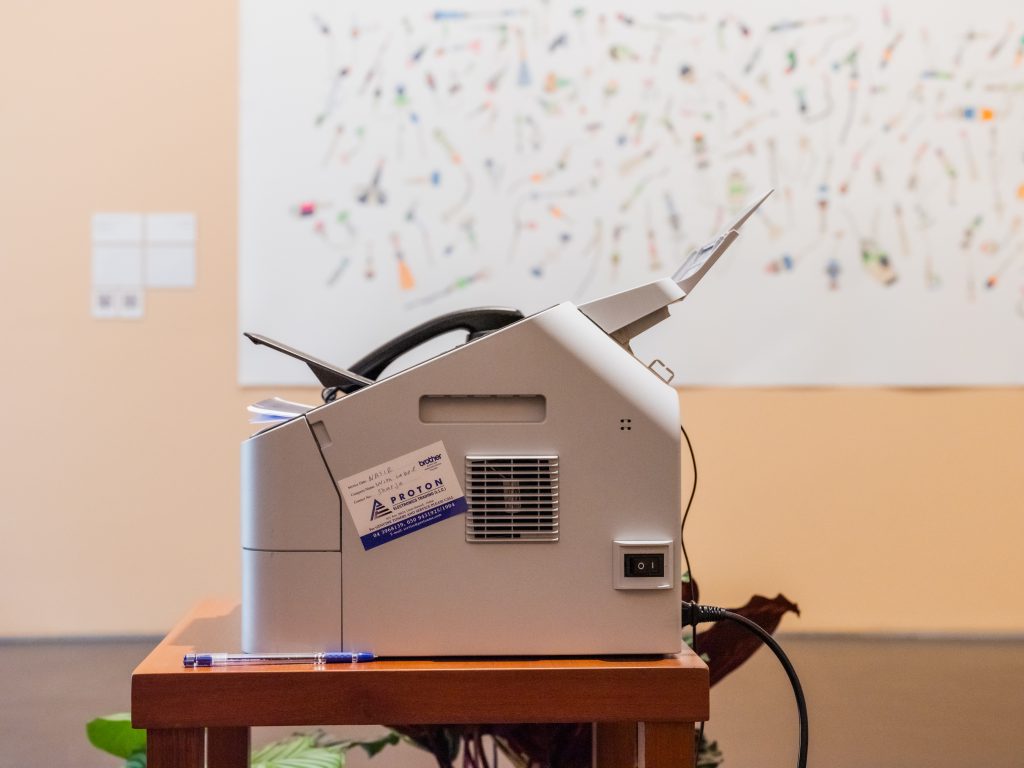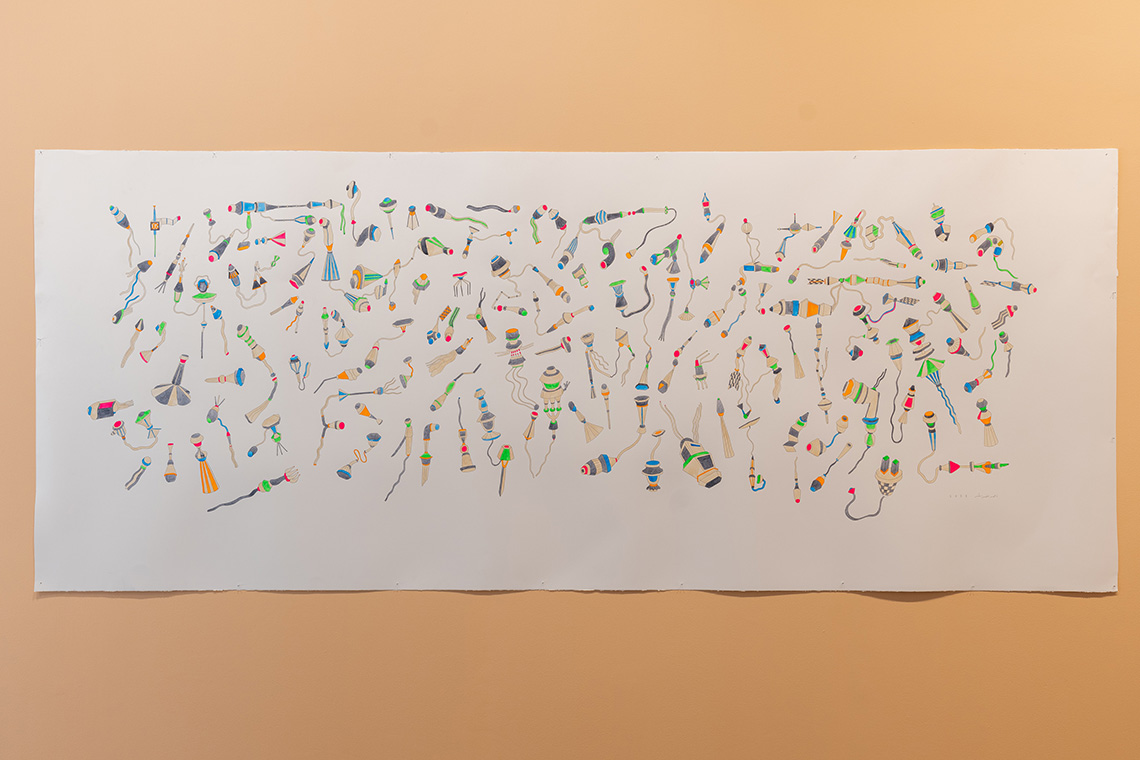Nasir Nasrallah draws on magic realism in his current exhibition Poetic of Machines at 421, which proposes a reality where humans and machines merge together.
The longer you look at Nasir Nasrallah’s The journey of living machines that are floating somewhere 01-02 (2023), the less you’re sure of what you’re looking at. Dominating one wall of Abu Dhabi’s 421 as part of the artist’s solo show Poetic of Machines, the ink-and-watercolour diptych depicts masses of mechanical parts that seem to morph into organic forms and then back again. Lazily sailing across the paper support, pieces of space junk trailing cables recall jellyfish tentacles or tadpole tails. What appears to be a pocket-sized pink UFO is in fact, at second glance, a spider with hinged legs, or perhaps one of John Wyndham’s triffids in miniature form. If you tilt your head just so, broken rockets or satellites become human torsos – one of them waving a three-fingered metal hand.
Nasrallah’s ‘living machines’ pervade the exhibition, which explores “the subtle interactions we have with technology, revealing deeper connections and parallel worlds that coexist,” the artist tells Canvas. The biological and mechanical merge across several drawings, with the figures wearing blithely smiling human faces in The Interaction, Tribes of the living machines, Rotation and sprouting flowers or hunks of flesh in The second life of used frames 01-07 (all 2023). In The mirror that does not reflect you only (2023), more living machines appear on the glass surface in blue acrylic ink, along with the image of the viewer and the humanoid objects in The journey on the opposite wall in the same plane – evoking the human-machine connection the artist proposes.
“I’ve always found inspiration in the concept of magic realism – it infuses a touch of fantasy and poetry into our everyday lives,” says Nasrallah. Described by Salman Rushdie, a master of the genre in literature, as “surrealism that arises out of the real”, magic realism emphasises the strangeness inherent in our everyday reality and invites us to perceive the world through a different lens. Tribes of the living machines, in which the creatures are organised into a grid of 12 rectangular frames, questions our tendency to form social groups predicated on the exclusion of non-members. Rotation reconsiders this line of questioning in turn by examining the other side of the coin: the sense of community that develops around social rituals. Reflecting this defamiliarising effect, where reality does not fall apart but is reconstructed, the composition of the works exhibits a certain logic with the living machines fitting together like puzzle pieces – or cogs in a machine.

Photography by Augustine Paredes of Seeing Things. Images courtesy of 421
While Nasrallah’s drawings cast a second look the structure of society, the exhibition’s centrepiece Faxes to myself (2023) collapses the concept of spacetime. Viewers are invited to send messages to the artist using a fax machine, and his responses are filed away in a binder along with faxes he has sent himself prior to the exhibition. The ordinary fax machine embodies his fascination with “how modes of communication connect disparate places and times, even though individuals may be physically separated by great distances,” as the exhibition catalogue puts it. Nasrallah’s ghostly presence as fax recipient is evoked by a sofa-and-table setup that mimics his personal studio. Here, too, humans and machines combine. Fax machines work by scanning a document as an image; handwriting, that imperfect typeface, is rendered electronic. In the machine’s paper tray, a group of visitors have left a tongue-in-cheek invitation to the ‘High Android Council’, addressed to Nasrallah and dated the year 201258.
In The comic of nonsense events (2023), this trope reappears in the form of a short, wordless comic book. On one page, a security camera protrudes from a woman’s eye; on another, a crying woman’s tears flow into the panel below, where they turn into a cloud of stardust from which a satellite emerges. Yet another page shows a small figure inside a floating apparatus with a person’s head, an illustration reproduced in a wool tapestry entitled The boy in a living machine (2023). The work pays homage to manga artist Maki Sasaki, known in the 1960s and 70s for his experimental, nonsensical narrative technique. Adopting a similar non-sequitur style, Nasrallah encourages the viewer to “formulate their own story by contemplating the connections between the disparate comic panels,” he says. “Through the interplay of imagination and interpretation, a unique and personal story emerges, guided by the viewer’s own perceptions and reflections.” Writing about the influence of magic realism on his practice in an essay published on his website, fellow Emirati artist Ebtisam Abdulaziz describes his work as a reflection of “how his mind processes his reality.” Perhaps The comic of nonsense events, in the same vein, proposes an ideationist philosophy where reality does not exist outside of human consciousness.

What, if anything, ties together these observations about reality in Poetic of Machines? For example, what is the nature of the relationship between humans and machines? In his foreword to the catalogue, Faisal Al Hassan, head of 421, suggests that the exhibition stresses the importance of artistic expression in the midst of technological advancement driven by capitalism. Or does it warn of an impending future in which we become indistinguishable from the devices that govern our lives? It’s tempting to wrap up the exhibition in a neat bow, but two neon LED word art pieces instruct us to approach the works by “resisting logic” and “supporting randomness”.
The artist dedicated Poetic of Machines to his late grandfather, who ran an antiquities shop in Sharjah’s Souq Al Arsah where the young Nasrallah grew up playing with spare parts. Such was his fascination with taking mechanisms apart that he would later pursue a university degree in telecommunication engineering, leading to a preoccupation with outdated communication tools such as land-line telephones, typewriters – and fax machines. Poetic of Machines is, perhaps, nothing more than an expression of childlike wonder and curiosity at the magic of how things work.
Poetic of Machines runs until 24 September 2023



